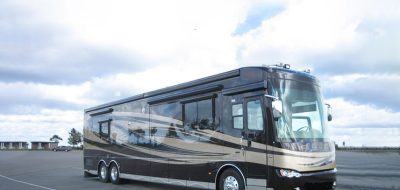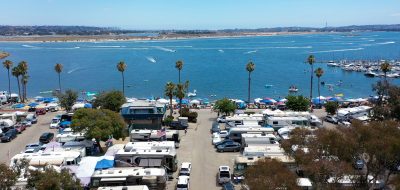 Hi, Folks! This month, we have some questions on winter camping, winter storage, and operational issues. Have a great Holiday, and a prosperous New Year, and remember to send your RVing questions to [email protected]
Hi, Folks! This month, we have some questions on winter camping, winter storage, and operational issues. Have a great Holiday, and a prosperous New Year, and remember to send your RVing questions to [email protected]
———————————————
Mark:
We would like to camp in cool weather without electricity. Can a battery safely run furnace blower? Thanks, Pat
Hi, Pat,
Your RV’s house battery will run the furnace, but if you have only a single battery, it may not be enough to keep the furnace running all night if it is really cold. Two batteries will usually support the furnace for 24 – 48 hours before they are depleted, depending on what else you might be running (lights, fans, etc.) Many RVers choose a vent-free propane heater for boondocking or dry-camping because they require no DC power to operate. Olympian catalytic heaters are an example of this type of heater.
These heaters run off your RV’s propane system, and require installation of a gas line and fittings to support them. Another popular option is the line of Buddy heaters, which can run on a small portable propane cylinder, making them very easy to use. http://www.mrheater.com/product/heaters/buddy-series.html. Have fun and stay warm!
———————————————-
Hi, Mark
We are new to the RV world! We bought a 29 foot travel trailer in June. It is being stored in a farm shed with one side open. We have removed all food and cleaned thoroughly. We have placed moth balls and pieces of soap around the tires and hitch. We have a number of dryer sheets placed on the inside as well. What else do you recommend for prevention of mice during the winter here in Minnesota? Thanks,
Bob
Hi, Bob
Removal of food and water are important, but mice will often enter RVs to nest even when no food is in there. The best way to prevent a rodent infestation is to mechanically exclude them. That means plugging every potential access hole or gap in your RV’s exterior. You can use expanding foam reinforced with hardware cloth or steel mesh, steel wool, or sheet metal. It can be a formidable task, but, unfortunately, most other methods are less than 100 percent effective. Repellents may or may not work, and many typically suggested repellents (dryer sheets, moth balls, etc.) seem to work better for some folks than others. Poison can be effective, but only if placed inside the rig and all sources of water inside are removed. These poisons dehydrate the mice, causing them to seek water outside the rig. This is supposed to prevent them from dying inside your RV. The key word here is “supposed.” If you decide that poison is appropriate, go to a local feed or agricultural supply store rather than the supermarket to buy it. The industrial-grade product is cheaper and more effective.
———————————————-
Mark:
What causes the cooling unit in a Dometic fridge to go bad? What is the most inexpensive way of repairing it? Any info will be much appreciated. Jeanette
Hi, Jeanette
Most RV absorption fridges fail either due to corrosion causing a leak in the cooling system, or due to operation off-level for extended periods. In most cases, you can replace just the cooling unit on your existing fridge. There are several companies out there who build new cooling units for most RV fridges. If your fridge is in good shape, but just doesn’t cool, that may be a good answer for you. A new cooling unit, with installation costs, will usually cost about half what a new fridge does. Check out these links:
We’re still talking about a significant expense. The cost of repairing or replacing an RV fridge has led many RVers to replace a dead fridge with a residential 120 volt fridge, and if you shop around, you can usually find something that will come pretty close to fitting in the original hole, but there are no “exact replacements” out there. You’ll need to do some carpentry to get a proper base for the fridge to sit on, find a way to secure it in place, and install some new trim to correct any gaps around the sides and top. It can be done, but it is a bit of a project. Yes, it will be a lot cheaper than a replacement RV fridge or cooling unit, but it will also tie you to electrical hookups, or require the installation of an inverter and a number of batteries if you wish to camp away from electrical hookups. If you always stay somewhere with electric hookups, no problem… if you like to boondock or dry camp a lot, it may not be a good choice.
——————————————–
Hi Mark,
I have a 2008 Tioga Ranger class C motor home. The 2 house batteries have an ‘off’ switch on the control panel for when it’s in storage, but I’m concerned about the engine battery. What kind of battery charger can I use on the engine battery when the RV is stored for a few months at a time where there is no outlet available for a plug-in charger? If solar is the answer, what wattage solar or trickle charger would be best? Thank you in advance, Donna
Hi, Donna
If you don’t have electrical power at your storage site, and you will be storing the RV for more than a month or two, your best option may be to remove both the house and the engine batteries from the rig and store then somewhere else, where you can run an automotive charger on them overnight about once a month. If that’s not an option, you need to provide some sort of maintenance charge to those batteries in the rig, and a small solar panel can be just the thing. I’d suggest one for the starter battery and another one for the house batteries. Make sure the batteries are fully charged before you set up the solar chargers: they will maintain a charged battery, but don’t have enough power to recharge a depleted battery. Most are in the 2-6 watt range. Coleman makes several sizes, and you can find them at Tractor Supply, Home Depo and online. Here’s a link to a pair on Amazon. http://www.amazon.com/Coleman-Solar-Volt-Battery-Maintainers/dp/B00KS6GTII and a link to the larger 6W panel at Home Depot. http://www.homedepot.com/p/Coleman-6-Watt-12-Volt-Solar-Battery-Maintainer-58022/203241530.
———————————————————
Mark, I have a fifth wheel and my question is…When traveling down the road does the power from my truck keep the battery charged supplying power to the fridge? Thanks, Sid
Hi, Sid
Most trailers have a dedicated wire in the umbilical (lighting) cord that provides a path for charge current to flow from the tow vehicle’s alternator to the trailer’s house batteries. The issue is that the length of that wire, coupled with its relatively small gauge, tends to limit the amperage that reaches the house batteries. In most cases, 10-15 amps of charge current is about the best you can expect. That won’t be enough to keep up with the energy use of most RV fridges running on an inverter. It is possible to improve that wiring system by increasing the gauge of the wire used, but it is difficult to do, and may not increase the capacity enough to support a fridge. Motorhomes usually have no problem with this, as the batteries are much closer, and the standard wiring is large enough to allow lots of current to flow, so most motorhomes will keep up with the fridge’s energy usage.
—————————————————
Hi, Mark
We recently purchased a fifth wheel, 35 ft. and would like to cover it for the winter. We were told by someone in the RV business that the poly coat on the camper will be ruined by a cover. Do you have any experience with this/with covers?
We appreciate your response. Randy and Joanne
Hi, Randy and Joanne
You can certainly use an RV cover when storing your rig. Just be sure to get a good quality cover that can be secured to the rig, and make sure it is constructed of breathable materials. A plain plastic tarp may do more harm than good if it allows moisture to build up underneath it! When shopping for a cover, look for the descriptive keyword “breathable.” This means that the cover will not be totally waterproof but will allow moisture that gets under the cover to evaporate. RV covers are available from Camping World and a number of online retailers. Check out rvcoversdirect.com. You can expect to pay $200 – $400 for a quality cover for your size RV, and I would be wary of “cheap” covers: Buy a name brand, like ADCO or Coverite, and it will serve you well. Be sure to attach it firmly to the RV with tie-downs as specified in the instructions. The cover should not be loose enough to flap in the wind, as that can damage painted surfaces.
——————————————
Founded in 1978, the Escapees RV Club provides a total support network for RVers that includes a wide variety of opportunities for fun, adventure, and education.
MAIL SERVICE The best mail–forwarding service in the country. Members can personalize their mail delivery receiving only the mail they want when they want. MAGAZINE Award-winning magazine written for RVers by RVers.
CHAPTERS There are 51 chapters across the U.S., Canada, and Mexico that offer local luncheons and rallies within 150 miles of home.
HOPs Theme–related outings and adventures held across the country.
ESCAPADES Five–day educational events that offer over 60 seminars and workshops to educate, entertain, and enhance the RV lifestyle.
PARKS Our discount park system offers a variety parking options. PLUS MUCH MORE!
A complete listing of all Escapees events and a comprehensive list of member benefits are found at www.escapees.











Steve
I am always curios about these catalytic propane heaters. Frequently they say safe for indoor use but they always say must use in a vented area. How is inside an RV considered vented. Below is from the camping world website.
Use inside RV as portable unit or permanently mounted
For use in vented areas only